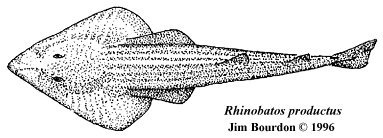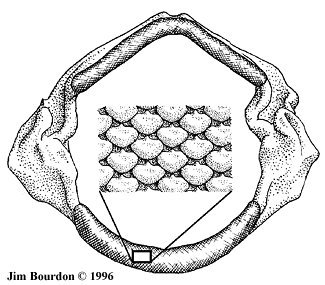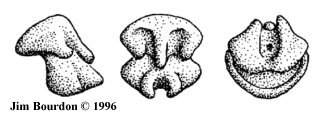|

General
Extant guitarfish of North American waters include the Atlantic species R. lentiginosus and its Pacific counterpart R. productus. These are an inshore species (to 60 feet), which feed predominantly on worms, crabs and clams.
Members of this suborder retain more primitive (shark-like) characteristics than other batoids; the tail is still strong and both caudal and dorsal fins are present. Guitarfishes tend to have a short snout, unnotched pelvic fins and small teeth forming a crushing dentition.

Stehmann (1981) distinguishes the two guitarfish families as follows:
RHYNCHOBATIDAE: "Caudal fin conspicuously bilobed, lunate in form, both lobes pointed; rear edges orf the pectoral fins falling short of origin of pelvic fins; origin of first dorsal fin over or slightly anterior to bases of pelvic fins."
RHINOBATIDAE: "Caudal fin not bilobed; rear edges orf the pectoral fins extending to origin of pelvic fins or further; origin of first dorsal fin well posterior to rear tips of pelvic fins."
Compagno (1999) included Rhynchobatus with the wedgefishes --
RHINIDAE MÜLLER & HENLE, 1841
Dentition
I have had the opportunity to obtain a
dentition of R. productus, and it has 104 upper and 117 lower files. With 20 teeth per file, the dentition holds over 4,000 teeth. This 4.2 foot fish had similarly shaped teeth which ranged from 0.5 to 1.0 mm in width (increasing in size mesially). A tooth from this dentition (Fig. 3) adhered to Cappetta's description and compared well with the fossil specimen.
 |
Fig. 2 R. productus dentition, width 9.8 cm
from 4.2' female caught off Ventura, CA.
Close-up of file structure from lower jaw (12x) |
 |
 |
|
Fig. 3 Tooth from dentition, width = 1.0 mm |
Teeth
The crown of these teeth are bulbous and there is a distinct, elongated, (lingual) uvula. Viewed basally, the roots have two lobes which form a triangular profile, narrowing lingually. There is a complete nutrient groove, yet the hemiaulacorhizous characteristic of a basal foramen connecting to lingual foramina is often retained. These foramina are coincidental with the notch that give each lobe its two-part appearance.
Cappetta's description of Rhinobatos teeth is very similar to that of Rhynchobatus. The main difference appears to be the relative lengths of the central and lateral uvulae, which are more pronounced in Rhinobatos.
|